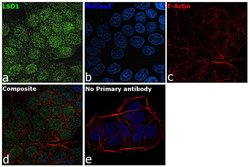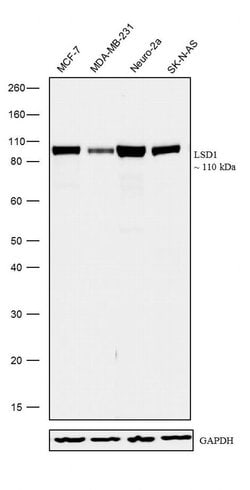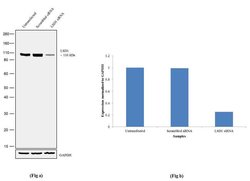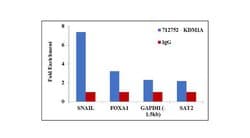Learn More
Invitrogen™ LSD1 Recombinant Superclonal™ Antibody (3HCLC)
Rabbit Recombinant Superclonal Antibody
Supplier: Invitrogen™ 712752

Description
This antibody is predicted to react with Mouse, Rat, Bovine Recombinant rabbit Superclonal™ antibodies are unique offerings from Thermo Fisher Scientific. They are comprised of a selection of multiple different recombinant monoclonal antibodies, providing the best of both worlds - the sensitivity of polyclonal antibodies with the specificity of monoclonal antibodies - all delivered with the consistency only found in a recombinant antibody. While functionally the same as a polyclonal antibody - recognizing multiple epitope sites on the target and producing higher detection sensitivity for low abundance targets - a recombinant rabbit Superclonal™ antibody has a known mixture of light and heavy chains. The exact population can be produced in every lot, circumventing the biological variability typically associated with polyclonal antibody production. Note: Formerly called Recombinant polyclonal antibody, this product is now rebranded as Recombinant Superclonal™ antibody. The physical product and the performance remain unchanged.
LSD1 is a histone demethylase that specifically demethylates 'Lys-4' of histone H3, a specific tag for epigenetic transcriptional activation, thereby acting as a corepressor. LSD1 contains a SWIRM domain, a FAD-binding motif, and an amine oxidase domain. This protein is a component of several histone deacetylase complexes, though it silences genes by functioning as a histone demethylase. It acts by oxidizing the substrate by FAD to generate the corresponding imine that is subsequently hydrolyzed. LSD1 demethylates both mono- and tri-methylted 'Lys-4' of histone H3. This protein may play a role in the repression of neuronal genes. Alone, it is unable to demethylate H3 'Lys-4' on nucleosomes and requires the presence of RCOR1/CoREST to achieve such activity. It may also demethylate 'Lys-9' of histone H3, a specific tag for epigenetic transcriptional repression, thereby leading to derepression of androgen receptor target genes. Mutations affecting this gene can result in cleft palate, psychomotor retardation, and distintive facial features.
Specifications
| LSD1 | |
| Recombinant Superclonal | |
| 0.5 mg/mL | |
| PBS with 0.09% sodium azide; pH 7.4 | |
| O60341, Q6ZQ88 | |
| KDM1A | |
| Protein corresponding to human LSD1 [aa500-aa852]. | |
| 100 μg | |
| Primary | |
| Human, Mouse | |
| Antibody | |
| IgG |
| ChIP Assay, Western Blot, Immunocytochemistry | |
| 3HCLC | |
| Unconjugated | |
| KDM1A | |
| 1810043O07Rik; AA408884; amine oxidase (flavin containing) domain 2; AOF2; BHC110; BRAF35-HDAC complex protein BHC110; CPRF; D4Ertd478e; FAD-binding protein BRAF35-HDAC complex, 110 kDa subunit; flavin-containing amine oxidase domain-containing protein 2; KDM1; KDM1A; KIAA0601; Lsd1; lysine (K)-specific demethylase 1; lysine (K)-specific demethylase 1A; lysine demethylase 1A; lysine-specific demethylase 1; lysine-specific histone demethylase 1; lysine-specific histone demethylase 1A; mKIAA0601; neuroprotective protein 3; RGD1562975; RP1-184J9.1; wu:fb82e06; wu:fc51a02; wu:fj36a05; wu:fj66b06 | |
| Rabbit | |
| Protein A | |
| RUO | |
| 23028, 99982 | |
| Store at 4°C short term. For long term storage, store at -20°C, avoiding freeze/thaw cycles. | |
| Liquid |
Safety and Handling
The Fisher Scientific Encompass Program offers items which are not part of our distribution portfolio. These products typically do not have pictures or detailed descriptions. However, we are committed to improving your shopping experience. Please use the form below to provide feedback related to the content on this product.



